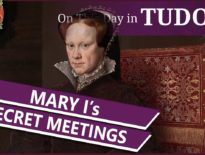On this day in Tudor history, 14th October 1565, diplomat and poet, Sir Thomas Chaloner the Elder, died at his home in Clerkenwell, London. He was just forty-four years old. He’d served four Tudor monarchs as a diplomat, but he also wrote English and Latin works.
Find out more about Thomas Chaloner, his life, his career, and how his teeth saved him from death, in today's talk.
J Stephan Edwards’ translation of Chaloner’s work on Lady Jane Grey - http://www.somegreymatter.com/chalonerelegy.htm
Also on this day in Tudor history, 14th October 1586, in the reign of Queen Elizabeth I, the trial of Mary, Queen of Scots, began at Fotheringhay Castle in Northamptonshire. Find out all about Mary's trial, what she was charged with and the evidence that Sir Francis Walsingham had gathered, in last year’s video:
Also on this day in history:
- 1536 – Pilgrimage of Grace. By 14th October the uprising in the north had turned into a proper rebellion. On 13th October, Lord Darcy had reported to Henry VIII that the East Riding, West Riding, North Riding and “all the commons of Yorkshire” were “up” in rebellion, and on 14th October William Haryngton, Mayor of York, and Sir George Lawson, wrote to the King asking for aid because “the commons… have rebelliously assembled to take York”.
- 1559 – Death of John Williams, Baron Williams and Lord President of the Council in the Marches of Wales, at Ludlow Castle. He was buried in Thame Church.
- 1593 – Death of Arthur Grey, 14th Baron Grey of Wilton, soldier and Lord Deputy of Ireland, at his home of Whaddon in Buckinghamshire. He was buried there. Grey had a reputation for radical Protestantism.
- 1596 – Death of John Coldwell, Bishop of Salisbury, at Salisbury. He was buried in the cathedral, in the grave of Bishop Wyvil due to his state of poverty.
Transcript:
On this day in Tudor history, 14th October 1565, diplomat and poet, Sir Thomas Chaloner the Elder, died at his home in Clerkenwell, London. He was just forty-four years old. He’d served four Tudor monarchs as a diplomat, but also wrote English and Latin works.
Let me give you a few facts about Chaloner…
• Sir Thomas Chaloner was born in London in 1521 and was the eldest son of mercer and administrator Roger Chaloner and his first wife, Margaret Middleton.
• Chaloner was educated at Cambridge University before joining the service of Thomas Cromwell, the king’s chief advisor, before or in 1538.
• In 1540, at the age of 19, Chaloner accompanied ambassador Sir Henry Knyvet to the Regensburg imperial diet as his secretary and then accompanied Emperor Charles V on his campaign against the Moors in Algiers in 1541. Storms saw Chaloner being shipwrecked off the coast of Algeria and Chaloner was only saved from drowning by holding onto a rope thrown from a galley with his teeth.
• In September 1547, in Edward VI’s reign, Chaloner was knighted by Lord Protector Somerset after fighting against the Scots at the Battle of Pinkie.
• In 1550, Chaloner married Joan Cotton, widow of Sir Thomas Leigh, but she died in January 1557 and they didn’t have any surviving children.
• In Edward VI’s reign and Mary I’s reign, Chaloner served as an MP and Justice of the Peace.
• In January 1549, he was one of those appointed to search the home of Lord Amdiral Thomas Seymour who’d been arrested for treason.
• In 1549, along with several others including William Cecil, his good friend, Chaloner testified in the deprivation trials of Edmund Bonner, Bishop of London, and Stephen Gardiner, Bishop of Winchester.
• In April 1553, Chaloner was sent to France to serve as special ambassador, but after the king’s death in July 1553 and the accession of Mary I, he was recalled. He had avoided being caught up in the Lady Jane Grey versus Mary I struggle of July 1553 but was still named in the general pardon given by Mary.
• In 1556, he served Mary I in Scotland, negotiating with Marie de Guise, the dowager queen, and also served Mary I in her campaign in France.
• During the reign of Elizabeth I, Chaloner acted as the English ambassador to Ferdinand I, Holy Roman Emperor, in 1558, and then ambassador to Philip II in the Low Countries, and then Spain between 1559 and 1561.
• In Spain, he suffered with health problems including malaria, rheumatism, stomach trouble and kidney stones. Due to his failing health, he was recalled in late 1563 but didn’t leave Spain for England until May 1565.
• In September 1565, he married Audrey or Ethelreda Frodsham.
• Chaloner died of a fever on 14th October 1565, having named his stepson, Audrey’s son, Thomas, as his heir. Thomas became known as Sir Thomas Chaloner the Younger. He was buried at St Paul’s Cathedral and his friend, poet Walter Haddon, wrote his epitaph:
“Nature and art in Chaloner combin’d
And, for his country, form’d the patriot’s mind.
With praise deserv’d his public posts he fill’d;
And equal fame his learned labours yield.
While yet he liv’d, he liv’d his country’s pride,
And first his country injur’d when he died.”
• Chaloner’s works include translations of Erasmus’s “Praise of Folly”, Gilbert Cousin’s Office of Servants,Sir John Cheke’s “An Homilie of Saint John Crysostome”, Ovid’s “Helen to Paris” and part of Boethius's Consolations of Philosophy. His Latin works include a ten-book-long didactic epic. He also contributed a poem on Richard II for William Baldwin’s “Mirror for Magistrates”.
• Chaloner also wrote an “Elegy on the Death of Lady Jane Grey” in Latin. Although he was away in France in 1553, historian J Stephan Edwards notes that he was good friends with many who knew the young queen, including Walter Haddon, John Cheke and William Cecil.



Leave a Reply